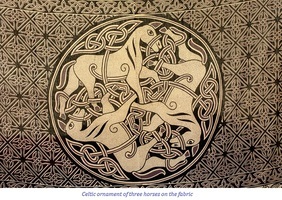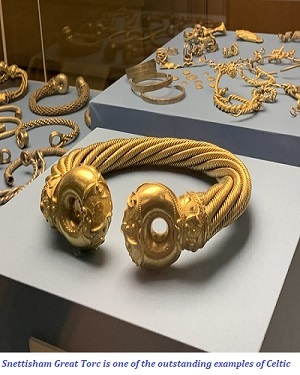
 Data Structure
Data Structure Networking
Networking RDBMS
RDBMS Operating System
Operating System Java
Java MS Excel
MS Excel iOS
iOS HTML
HTML CSS
CSS Android
Android Python
Python C Programming
C Programming C++
C++ C#
C# MongoDB
MongoDB MySQL
MySQL Javascript
Javascript PHP
PHPPhysics
Chemistry
Biology
Mathematics
English
Economics
Psychology
Social Studies
Fashion Studies
Legal Studies
- Selected Reading
- UPSC IAS Exams Notes
- Developer's Best Practices
- Questions and Answers
- Effective Resume Writing
- HR Interview Questions
- Computer Glossary
- Who is Who
Ancient Celtic Art
Introduction
Ancient Celtic art had two distinct styles: The Hallstatt and the la Tene style, which influenced art in the Mediterranean and Estuscan styles.
Art describes people's thinking, which is why it is an important factor in determining history. Celtic art, as found by archaeologists, dates back to 1000 BC. Ancient Celtic Art was found in Austria but was spread across a wider region.
Celtic art includes sculptures of Gods, naked warriors, forest animals and vegetal designs, and Romans and Thracians influenced it. They could also show the beauty of the smallest things in their art and convey through their messages of love, religion and power.
Overview of Ancient Celtic Art
Celtic art is related to the people known as Celts who lived in Europe and spoke the Celt language. Their art form is distinct as it is mostly ornamental, and it avoided using straight lines but used symmetry in some and tried to convey symbolism in a complex way.
Ancient Celts were inspired by their designs of Caucasian Bronze Age, Mediterranean, and Estruscan styles when they came in contact with them during maritime trading. The first area of arts during the Celtic Age was Hallstatt culture near Austria, but it spread to a wider region. It was noted for its high-quality tools made of iron, bronze decorative items, and ornamentation.
Forms of Ancient Celtic Art
There were many forms of ancient Celtic Art like Celtic Sculpture, Celtic shields, Celtic Torcs, Celtic Cauldrons, Celtic Brooches, Celtic Pottery, etc.
Celtic Sculpture − Celtic Sculpture was made from stone, metal, wood, bronze, and gold. The decoration and extra forms were achieved by tracing, punching, and engraving. Extra details were added in colorful materials like glass such as coral, amber, and enamel. Early Celtic sculptures focused on human forms, especially heads.
Celtic Shields − Warriors during the Celtic period had their shields, and they were so intricately designed that they looked like a piece of art. They were made of wool and leather, and the buckles were in metals with a strong center for more strength. The Battersea shield, recovered from the River Thames, is placed in the British Museum. It is a fantastic example of Celtic craftsmanship.
Celtic Torcs − Made from copper, gold, silver, iron, and bronze, these Torcs were thought to be worn around necks, or maybe it was offered in rituals and stored as wealth, and it was also considered the spiritual significance that it would bring luck to the wearer. The Snettisham Great Torc is a fine example of this type of Celtic Art.
Celtic Cauldrons − Celtic Cauldrons held a special place as they represented regeneration and abundance, and in some mythology, it meant unending food production. They were used during feasts and other festivities. Made in sheet bronze, they were suspended over the fire when food was cooked.
Celtic Brooches − The Celts were fond of brooches and pins, primarily used to hold pieces of cloth together. They were developed in plain bronze but slowly became a symbol of high status, which women, men and children wore. These were mostly shaped in animal forms like horses, snakes, and sometimes human heads and innate objects like bells and drums.
Celtic Pottery − The Celts carved their pottery vessels intricately. They were dark in colour or mostly red with black decorations. They were very fond of wine, so they made a flask with a long neck which came to be known as Linsenflashe. They were round with no rims or handles.
Techniques Used in Ancient Celtic Art
There were many forms of Ancient Celtic Art. But Hallstatt and La Tene are considered the most significant that gave rise to more new forms like plastic, sword, and Waldagesheim styles.
Plastic Style − It dates back to the 3rd Century BC.
 The type of metalwork involved molding natural forms into abstract forms to create three-dimensional grotesque images. It was La Tene's form of Celtic Art.
The type of metalwork involved molding natural forms into abstract forms to create three-dimensional grotesque images. It was La Tene's form of Celtic Art.Sword Style − The Sword style dates back to the 3rd Century. Sword-style form of Celtic Art included engraved, two-dimensional asymmetrical patterns.
Waldagesheim Style − This form of Celtic Art is named after the place in Germany called Waldagesheim. It was discovered in bracelets and torcs in graves. Dating back to the 4th Century BC, this style has abstract patterns in the metal.
Significance of Ancient Celtic Art
The significance of Ancient Celtic Art on modern art and culture is immense, and it highlights the use of metals like copper, bronze, gold, and silver and how their molding properties were used to make exquisite pieces of art, the influence of foreign elements on Celtic art is seen in the various artifacts that are discovered. In the 19th Century, Celtic art was revived with the discovery of brooches, which increased interest in this art form.
Conclusion
Ancient Celtic art had two distinct styles that influenced it: the La Tene and Hallstatt styles. These styles combine various cultures and are an amalgamation of Celtic Art seen in the museums. Archaeologists discovered various art pieces from this period, leading to further study, and Celtic Art got the recognition it deserved.
FAQs
Q1. When and where was Celtic Art Discovered?
Ans. Celtic art was discovered in 1000 BC in Austria, although it was spread across a huge region.
Q2. When did Waldageisheim style become an integral part of ancient Celtic Art?
Ans. Named after a place in Germany, Waldageisheim, archeologists noticed a different pattern in the torcs and bracelets. It proved that for some reason, Waldageisheim art was an integral part of Celtic art.
Q3. What Inspired the Ancient Celts?
Ans. The Ancient Celts were influenced by the Mediterranean, Etruscan, and Caucasian Bronze age art. However, they also used different styles to create their own art.

